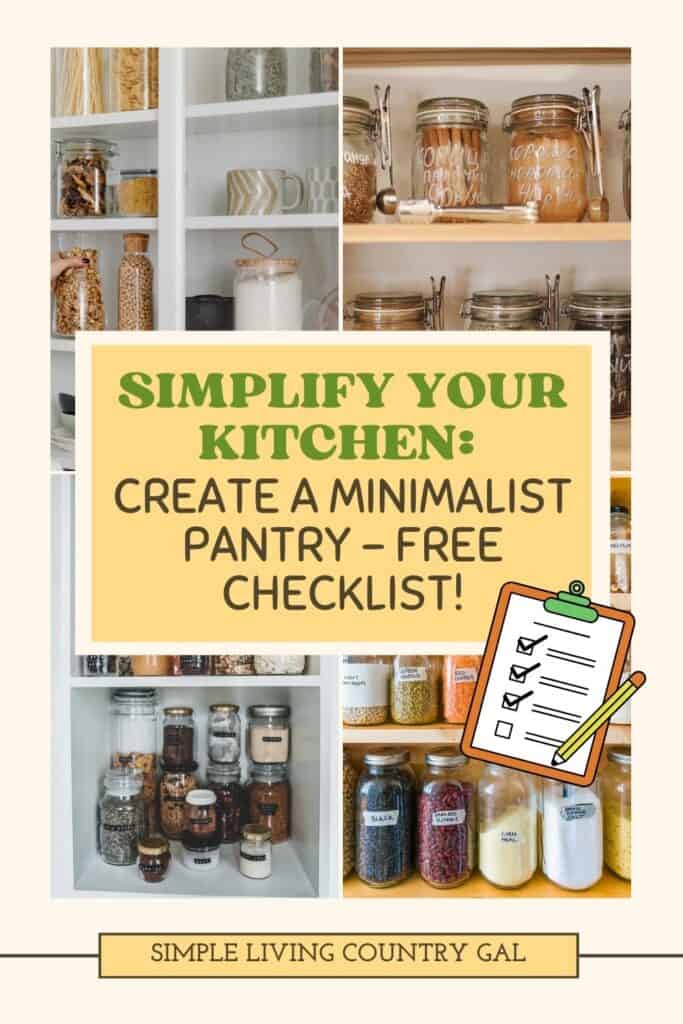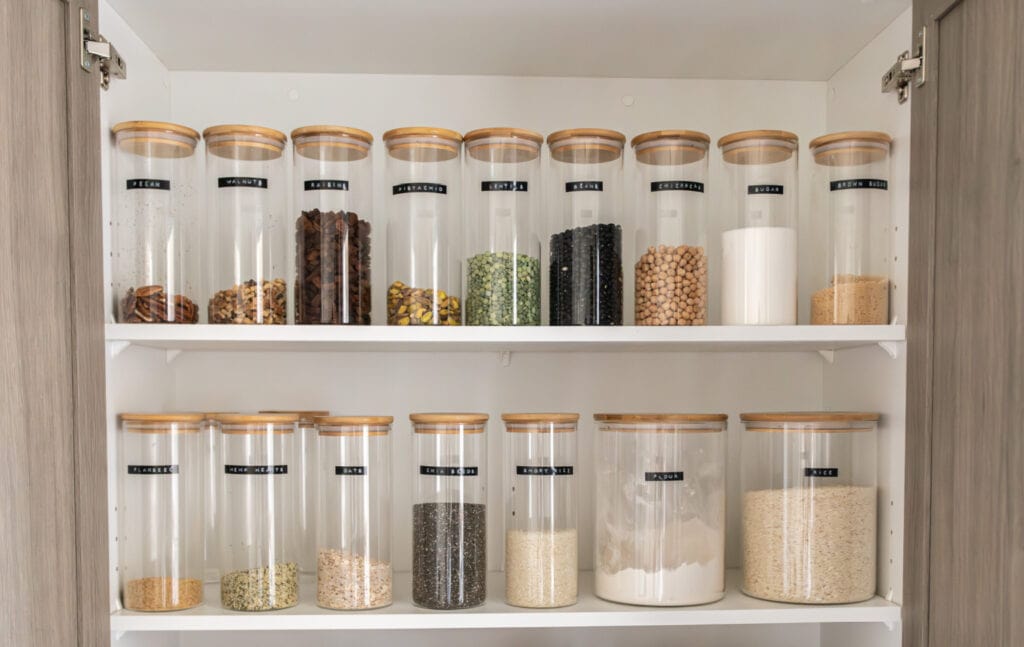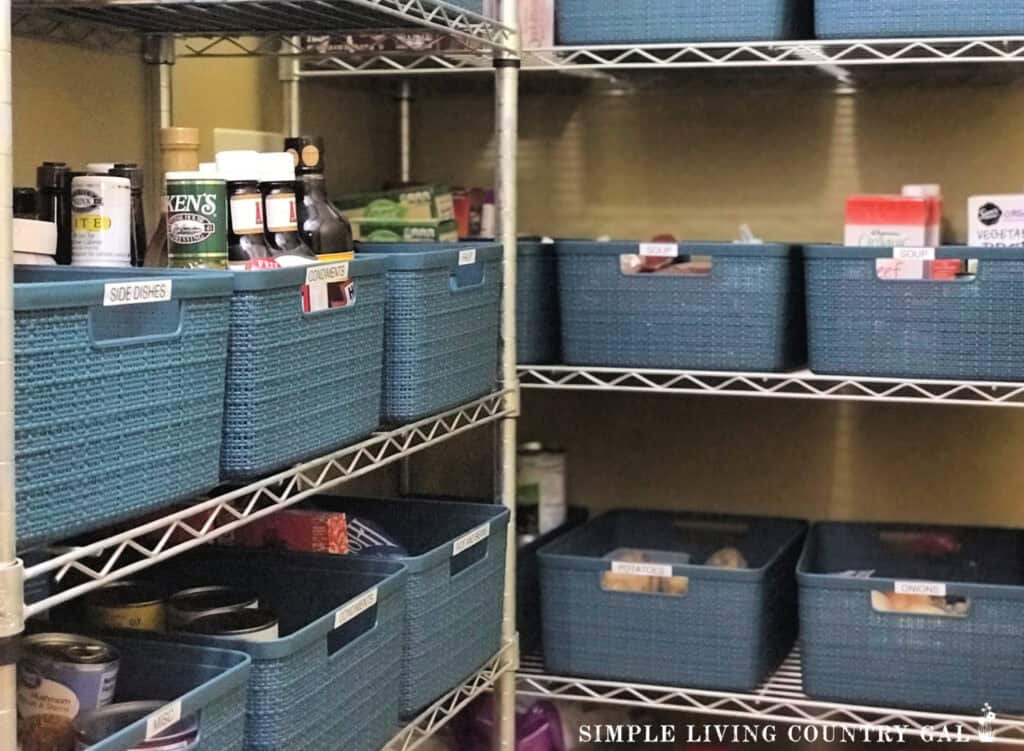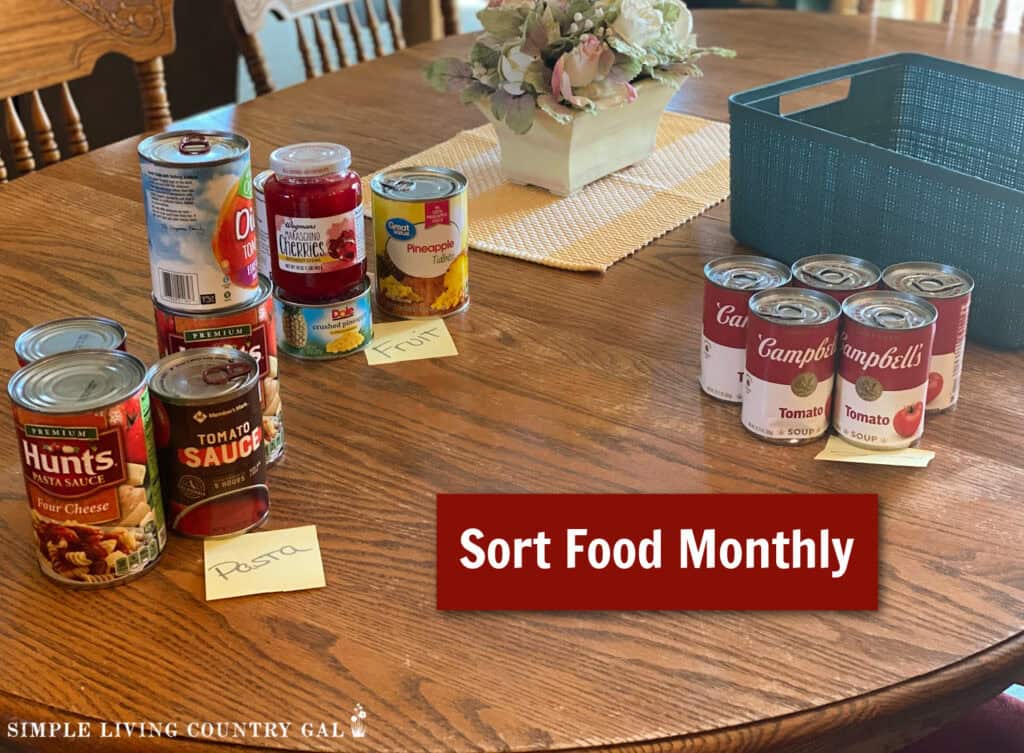minimalist pantry
Setting up a minimalist pantry will help you to streamline your kitchen food storage areas. Being organized with the food you keep on hand will help you to have a household budget that is more on track and realistic.
This guide to simple living will help you to set up a pantry filled with the ingredients you know you will use.

When we talk about minimalism, our thoughts usually go right to the closet, and for good reason. Having fewer things to wear can be a game changer in keeping a neater space.
When you think of food storage, minimalism is not usually a word you think of. However, keeping a system in your pantry can be very helpful.
What is minimalism?
Minimalism is a lifestyle that emphasizes simplicity. It encompasses reducing excess and decluttering physical spaces, allowing folks to be more productive throughout their days mainly because they have fewer decisions to make.
Minimalism is more than downsizing what you have; it also promotes mindful living and prioritizes experiences, relationships, and well-being over things.

Minimalism helps to remove distractions, saves you time throughout the day, and puts the focus on quality rather than quantity.
When you can bring minimalism into your pantry you will find it easier to organize the food you have on hand more easily and fill this important space with things you routinely use.
What Staples Belong in a Pantry?
Building a well-stocked pantry is essential to embracing minimalism in your kitchen. The key is to focus on ingredients that can be used in a variety of meals that your family routine eats.
- Grains: This includes rice, pasta, and quinoa.
- Canned Goods: This includes fruits, vegetables, sauces, and beans.
- Herbs and Spices: Be sure you have commonly used staples such as salt, pepper, garlic powder, Italian seasonings, rubs, and dried herbs.
- Oils and Vinegar: This includes healthy options such as olive and coconut oil, along with a few types of vinegar, like balsamic and apple cider.
- Nuts and Seeds: This includes for baking and snacking.
- Condiments: This includes any condiments that your family routinely uses.
Keeping a few key ingredients on hand, you can customize your pantry to fit your family’s tastes.

SLCG Pro Tip: for any ingredients you use often, always have a backup in your pantry. for our family, it’s hot sauce. My boys love to add it to anything I make, and running out is a catastrophe, and no, I am not exaggerating about this.
I now keep a backup bottle or two in my pantry and once that backup is opened, that is when I add it to my list. This tip will help to ensure you never run out of a key item in your kitchen.
How to Set Up a Minimalist Pantry
Before you start sorting things out and tossing food, you will need to do some planning. This will help you stay on target with the foods you decide to keep.
Make a List of Family Meal Favorites
Start by making a list of meals you know your family loves. This will help you streamline your pantry and meal planning as well.
Get tips on how to make and use a weekly menu for our easy approach to meal planning.
Action Steps:
- List out 5-10 family favorites. Things you routinely make over and over again.
- Next to each recipe, list the ingredients you need to have.

Make a list of Side Dish Staples
Next, you will want to be sure you have a few easy-to-prepare side dishes in your pantry that you can quickly put on the table.
Here are a few ideas:
- Seasoned Rice
- Noodles
- Veggies
- Stuffing and gravy
- Potatoes
Action List:
- List out side dishes that you know your family enjoys.
- Have a stock of 1-2 options for each dish in your pantry.
Keep this list with your meal planning papers so you can use it when making your weekly shopping list.
Explore simple cooking tips for the kitchen and make snacks with the healthiest ingredients.
Make a list of Snacks
Another important part of a pantry is the snacks you have for you and your family to enjoy. The key is to not buy things to have them. Instead, customize the snacks you have to cut down on wasted spending.
Action Steps:
- Ask each family member what snacks they enjoy.
- Set up a bin for each labeled with their name.
- Use colors for younger children.
- Fill each bin with snacks and only replenish weekly.
Family snack bins reduce binge eating, unhealthy choices, and messy shelves caused by digging or searching for an afterschool snack.
Spectrum Wire Basket for Organizing (Medium, Industrial Gray) – Sturdy Scoop Pantry Basket Storage – Wire Storage Basket Organizer for Kitchen, Shelf, Closet, Bathroom, Garage & MoreTB Home 14” Bamboo Wood Lazy Susan Organizer for Kitchen, Turntable for Cabinet, Countertop, Table or Pantry
Airtight Food Storage Container Set – 7 Piece Set Clear Plastic Canisters For Cereal, Flour with Easy Lock Lids, for Kitchen Pantry Organization and Storage, Include Labels and Marker (White)
Stock up on Baking Essentials
Baking food from scratch can put you in control of what you and your family eat and snack on. Making a homemade muffin allows you to customize the ingredients and add in things your kids may not normally eat, taking it from a junk food item and turning it into a healthy afternoon snack.
Stocking a baking area in your pantry is a great way to encourage more baking and will help to keep sugary options out of your kitchen pantry.
Key Baking Ingredients:
- Flour – all-purpose, whole wheat, almond, coconut.
- Sugar – granulated, brown, powdered.
- Baking powder and baking soda.
- Salt.
- Vanilla extract.
- Eggs.
- Milk or dairy-free alternative (almond milk, coconut milk).
- Butter or oil (coconut oil is a healthier option).
- Chocolate chips or other mix-ins (nuts, dried fruits).
- Spices (cinnamon, nutmeg, ginger) for added flavor.
Action List:
- Set up a few baking bins in your pantry.
- Fill them with common ingredients you routinely use.
Now, whenever you need a treat, you can whip up something healthier and enjoy a guilt-free snack.

Minimalist Tips for Grocery Shopping
Use these tips to help you stay on track with purchases so you only bring home the food you know your family will eat and enjoy.
Tip #1. Don’t buy it for the price
Just because an item is on sale doesn’t mean you should buy it. If your family won’t eat it or it’s not a healthy option, it’s not worth the cheaper price.
Tip #2. Stick to a grocery list
Create a weekly meal plan and make a list of the ingredients needed for each meal. Be sure to shop your pantry first before you head to the store. Stick to this list when shopping to avoid impulse buys or buying items you already have enough of at home.
Tip #3. Shop in bulk
Buying certain items in bulk can save you money, especially if they are non-perishable items like baking ingredients, grains, beans, and canned goods. Just be mindful of the expiration dates and how quickly you will use something up before it goes bad.
Tip #4. Buy seasonal produce
Seasonal fruits and vegetables are cheaper and often fresher than out-of-season options. Take advantage of the calendar and stock up on things that are cheaper during those times. Freeze, can, or dehydrate enough to get you through the year.
SLCG Pro Tip: If you have the time and space, consider starting a vegetable garden. This not only gives you a great selection of fresh food to enjoy in the season, but you can grow enough to preserve, filling your pantry with fresh organic options.
Remember, the same rule applies here: Do not grow it just to grow it. Only plant things you know your family will enjoy, making the work investment worth it.
DIY Cleaners Recipe Book.

Tip #5. Shop the perimeter of the store
The outer aisles of a grocery store typically have the freshest and healthiest options. Next time you are shopping, challenge yourself to stick to the outside, and you may find healthier items in your cart at checkout.
Tip #6. Look for that discount cart
Many grocery stores will have a discount bakery cart set up somewhere in the store. This is a great way to get homemade bread that you can freeze and enjoy with a meal.
Keep Your Pantry Organized
Finally, there is one more tip to talk about that is a key part of setting up and keeping a minimalist pantry. Do a routine declutter and sort.
Do a Routine Sort
Every few months, go through the food in your pantry, checking expiration dates. If you find things you are routinely tossing, you may want to consider skipping over those things next time you are at the store.

Use Containers
Use bins and baskets to group food categories. Bins for PASTA, BREAKFAST, BAKING, and SOUPS are great. Containers are a great way to keep a pantry more organized and neater.
Get our pantry categories list for your kitchen storage.
First in First Out Rule
Whenever you bring food home, put the newest items behind what you already have. This will ensure that things are getting used in order.
Remember, even if it’s a good deal, it is still money wasted if your family does not eat it. Set up a minimalist pantry and only purchase the foods that you know your family will eat and enjoy. This tip will help you to save money, eat healthier, and keep an organized food storage area in your kitchen.






